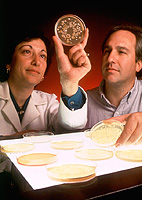Microbiologist: Difference between revisions
No edit summary |
Danfratamico (talk | contribs) No edit summary |
||
| Line 1: | Line 1: | ||
[[Image:USDA ARS ERRC.jpg|right|thumb|200px| Microbiologists examining cultures on a [[Petri dish]].]] |
[[Image:USDA ARS ERRC.jpg|right|thumb|200px| Microbiologists examining cultures on a [[Petri dish]].]] |
||
'Micro'means 'tiny' which usually refers to particles which cannot be seen in the naked eye.A '''microbiologist''' is a person who investigates things or studies in the field |
'Micro' means 'tiny' which usually refers to particles which cannot be seen in the naked eye. A '''microbiologist''' is a person who investigates things or studies in the field |
||
'''[[microbiology]]'''. Microbiologists investigate the growth and |
'''[[microbiology]]'''. Microbiologists investigate the growth and |
||
characteristics of microscopic organisms such as [[bacteria]], [[algae]], or [[fungi]]. |
characteristics of microscopic organisms such as [[bacteria]], [[algae]], or [[fungi]]. |
||
Revision as of 14:21, 26 June 2012

'Micro' means 'tiny' which usually refers to particles which cannot be seen in the naked eye. A microbiologist is a person who investigates things or studies in the field microbiology. Microbiologists investigate the growth and characteristics of microscopic organisms such as bacteria, algae, or fungi. Most microbiologists specialize in environmental, food, agricultural, or industrial microbiology; virology (the study of viruses); immunology (the study of mechanisms that fight infections); or bioinformatics. Many microbiologists use biotechnology to advance knowledge of cell reproduction and human disease.[1] As of 2008, there were 16,900 microbiologists employed in the United States, with this number projected to increase 12.2% over the following decade.[2]
Fields in microbiology
Specialists in the broad field of microbiology include:
- Bacteriologists, who work in the field of bacteriology and study bacteria.
- Environmental microbiologists - work in the field of environmental microbiology and study microbial processes in the environment.
- Food microbiologists, who work in the food industry and study pathogenic microorganisms that cause foodborne illness and spoilage.
- Industrial microbiologists who generally work in biotechnology and study microorganisms that produce useful products.
- Medical microbiologists, medical practitioners (physicians) who have chosen to specialize in the diagnosis and treatment of microbial diseases in patients.
- Mycologists, work in the field of mycology and study fungi.
- Protozoologists, who work in the field of protozoology and study protists.
- Virologists, who work in the field of virology and study viruses.
- Microbial epidemiologists, who study the role of microorganisms in health and illness.
- Immunologists, who study how the body defends itself against viruses, bacteria, and etc.
History
Antonie van Leeuwenhoek of the Netherlands is commonly known as "the Father of Microbiology", and is considered to be the first microbiologist.
References
- ^ Bureau of Labor Statistics (2010). "Biological Scientists". Occupational Outlook Handbook, 2010-11 Edition. Retrieved 2011-12-03.
- ^ Bureau of Labor Statistics (2011). "Employment by industry, occupation, and percent distribution, 2008 and projected 2018: Microbiologists" (PDF). 2008-18 National Employment Matrix. Retrieved 2011-12-03.
![]() This article incorporates text from this source, which is in the public domain: Occupational Outlook Handbook, 2010-11 Edition, Bureau of Labor Statistics
This article incorporates text from this source, which is in the public domain: Occupational Outlook Handbook, 2010-11 Edition, Bureau of Labor Statistics
See also
